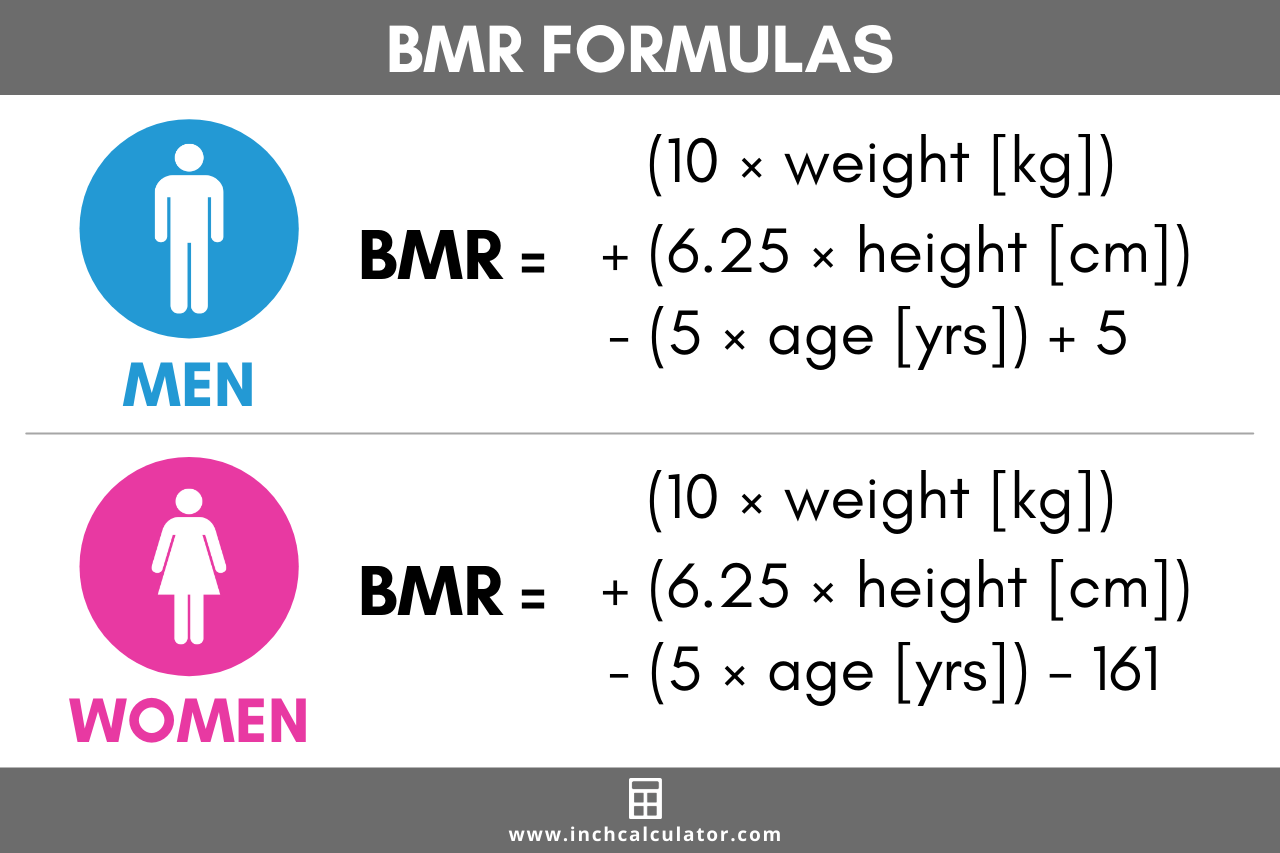Mifflin St. Jeor Calculator (TDEE & BMR)
Calculate TDEE & BMR using the Mifflin St. Jeor equation.
Calculated TDEE:
| Activity Level | Calories |
|---|---|
| Basal Metabolic Rate (BMR) | |
| little to no exercise | |
| light exercise 1-3 times per week | |
| moderate exercise 3-5 times per week | |
| heavy physical exercise 5-6 times per week | |
| heavy physical exercise 6-7 times per week |
Calculated BMI
On this page:
How to Calculate BMR using the Mifflin St Jeor Equation
Basal metabolic rate is the amount of energy needed for your body’s physiological functions at rest, such as your breathing, your heart beating, and your brain activity.
This amount of energy required is measured in kilocalories, or often just denoted as calories. Therefore, BMR is your body’s calorie needs at rest with no extra activity.
In order to measure your exact BMR, you need to be in a lab setting where indirect calorimetry is used. This measurement is made under tightly controlled conditions and not easily accessible to most people.
The value of caloric expenditure that is measured by indirect calorimetry can then be added to physical activity energy expenditure to calculate total daily energy expenditure.[2]
Since most people don’t have the ability to have indirect calorimetry performed, formulas have been created to calculate BMR using weight, height, age, and gender.

Mifflin St Jeor Equation
The Mifflin-St Jeor equation[3] is one of the most widely used BMR formulas. It appears to provide a closer estimate of true BMR than the Harris-Benedict equation.
Studies have found that it is more likely than other equations to estimate basal metabolic rate to within 10% of that measured by indirect calorimetry.[4]
There are two different equations for men and women due to different rates of metabolism based on gender.
Men:
BMR = (10 × weight [kg]) + (6.25 × height [cm]) – (5 × age [years]) + 5
Women:
BMR = (10 × weight [kg]) + (6.25 × height [cm]) – (5 × age [years]) – 161
If you are using imperial units, you can convert weight to kilograms by dividing weight in pounds by 2.2. To convert height to centimeters, multiply height in inches by 2.54.
For example, let’s calculate the BMR of a 36-year-old woman weighing 120 pounds with a height of 65 inches using the Mifflin St. Jeor equation.
Start by converting her height and weight to imperial units. Our length and weight conversion utilities might help here.
120 lbs ÷ 2.2 = 54.55 kg
65 inches × 2.54 = 165.1 cm
Then, apply the Mifflin St. Jeor equation to calculate BMR.
BMR = (10 × 54.55) + (6.25 × 165.1) – (5 × 35) – 161
BMR = 1,241 kcal
So, this person has a BMR of 1,41 calories.
How to Calculate TDEE with the Mifflin St. Jeor Formula
Your BMR is only your energy needs at rest. To determine how many calories you expend on a daily basis, you also need to factor in your physical activities. This will then give you your total daily energy expenditure, or TDEE.
To find your TDEE, the best approach is to multiply your resting energy expenditure (or basal metabolic rate) by an activity factor, as found in the TDEE calculator. This will give an estimate of the number of calories you burn on any given day.
The following table shows the activity factor for various levels of exertion:[5]
| Level of Activity | Example | Activity Factor |
|---|---|---|
| Sedentary | Little to no exercise, such as a desk job with no additional physical activity | 1.2 |
| Lightly Active | Light exercise 1-2 days/week | 1.375 |
| Moderately Active | Moderate exercise 3-5 days/week | 1.55 |
| Very Active | Hard exercise 6-7 days/week | 1.725 |
| Extremely Active | Hard daily exercise and physical job or two times a day training | 1.9 |
For example, the 36-year-old woman above would only need to consume around 1,241 calories if she was completely at rest.
However, if she is extremely active, her total daily energy expenditure can be found using a multiplier of 1.9 like this.
TDEE = 1,241 × 1.9 = 2,358 kcal
Thus, this woman has a total daily energy expenditure of 2,358 calories. This demonstrates how physical activity plays a big role in burning calories throughout the day.
While these formulas are only guidelines, they can help you estimate your daily calorie needs based on your basal metabolic rate and activity factor. The Mifflin St Jeor Equation has been found to be one of the more accurate ways to compute BMR and TDEE.
In fact, a study from the Journal of Science and Medicine in Sport found that the Mifflin St Jeor equation and Harris-Benedict equation predicted resting metabolic rate within ±10% of a MedGem® metabolic analyzer.[6]
Calculating your total daily energy expenditure using these formulas allows you to calculate your daily calorie needs. This can help you maintain a healthy weight or aid in weight loss if you are counting calories throughout the day.
References
- Centers for Disease Control and Prevention, About Adult BMI, https://www.cdc.gov/healthyweight/assessing/bmi/adult_bmi/index.html
- da Rocha, E. E. M., Alves, V. G. F., & da Fonseca, R. B. V., Indirect calorimetry: methodology, instruments and clinical application, Current Opinion in Clinical Nutrition & Metabolic Care, 2006, 9(3), 247-256. https://journals.lww.com/co-clinicalnutrition/Abstract/2006/05000/Indirect_calorimetry__methodology,_instruments_and.12.aspx
- Mifflin, M. D., St Jeor, S. T., Hill, L. A., Scott, B. J., Daugherty, S. A., & Koh, Y. O., A new predictive equation for resting energy expenditure in healthy individuals, The American Journal of Clinical Nutrition, 1990, 51(2), 241–247. https://doi.org/10.1093/ajcn/51.2.241
- Frankenfield, D., Roth-Yousey, L., & Compher, C., Comparison of predictive equations for resting metabolic rate in healthy nonobese and obese adults: a systematic review, Journal of the American Dietetic Association, 2005, 105(5), 775–789. https://pubmed.ncbi.nlm.nih.gov/15883556/
- Kelly, M., Resting Metabolic Rate: Best Ways to Measure It—And Raise It, Too, American Council on Exercise, https://www.acefitness.org/certifiednewsarticle/2882/resting-metabolic-rate-best-ways-to-measure-it-and-raise-it-too/
- Hasson, R. E., Howe, C. A., Jones, B. L., & Freedson, P. S., Accuracy of four resting metabolic rate prediction equations: effects of sex, body mass index, age, and race/ethnicity, Journal of Science and Medicine in Sport, 2011, 14(4), 344-351. https://www.sciencedirect.com/science/article/abs/pii/S1440244011000417



